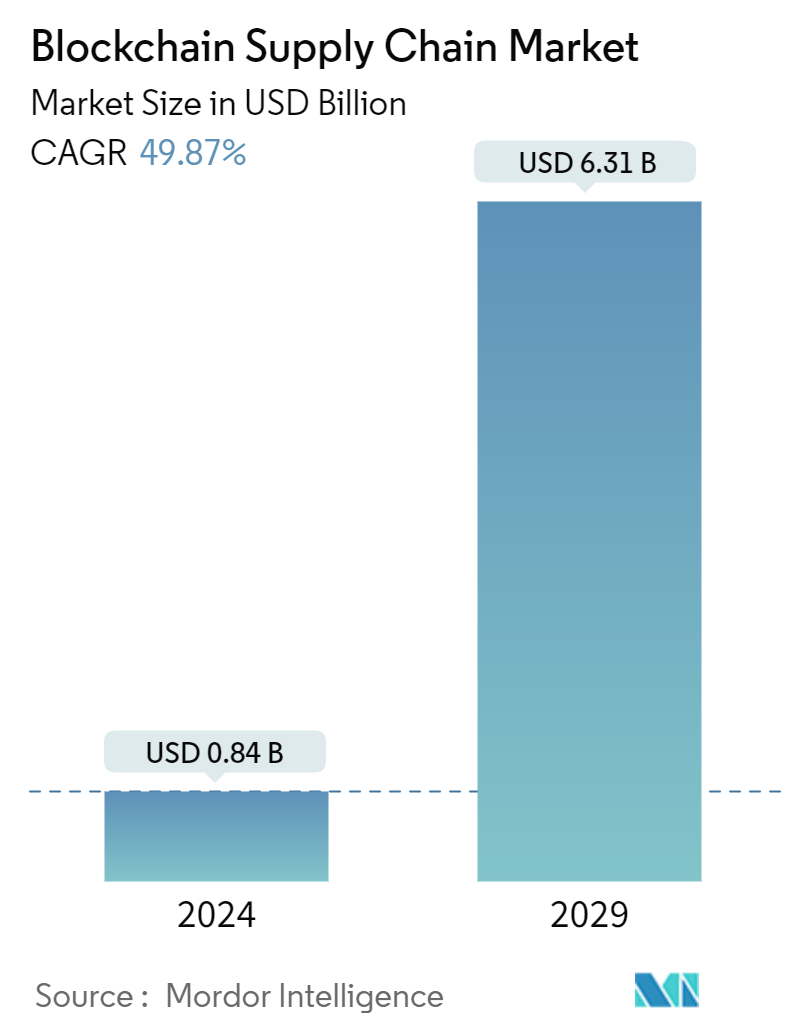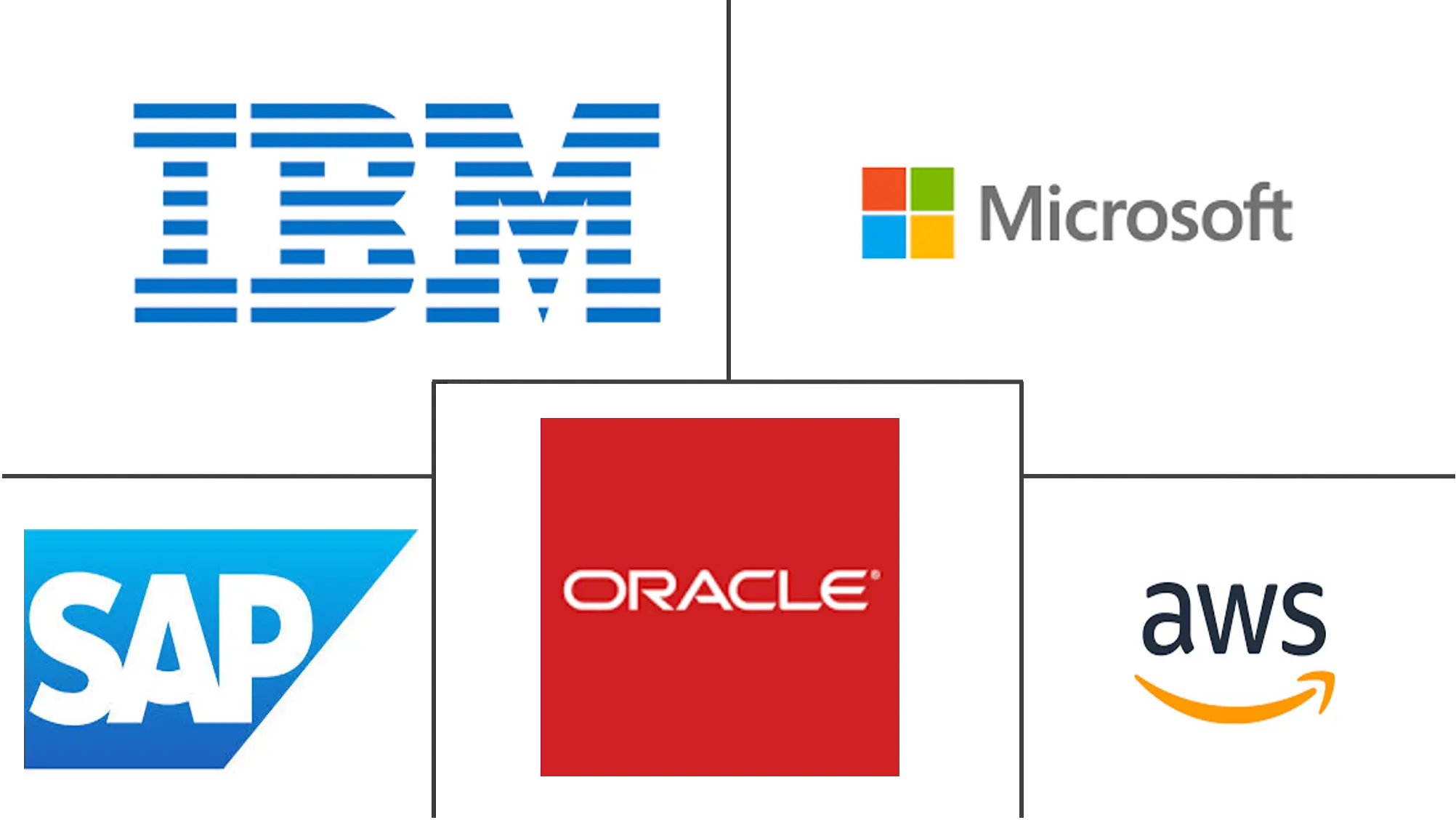Market Size of Blockchain Supply Chain Industry

| Study Period | 2019 - 2029 |
| Market Size (2024) | USD 0.84 Billion |
| Market Size (2029) | USD 6.31 Billion |
| CAGR (2024 - 2029) | 49.87 % |
| Fastest Growing Market | Asia Pacific |
| Largest Market | North America |
Major Players
*Disclaimer: Major Players sorted in no particular order |
Blockchain Supply Chain Market Analysis
The Blockchain Supply Chain Market size is estimated at USD 0.84 billion in 2024, and is expected to reach USD 6.31 billion by 2029, growing at a CAGR of 49.87% during the forecast period (2024-2029).
A growing requirement for supply chain transparency and surging demand for heightened security of supply chain transactions are significant growth factors for the market. Increased automation and removal of intermediaries with blockchain in supply chain management would generate possibilities for market growth.
- The platform component part dominated the overall blockchain supply chain market and is anticipated to remain aggressive due to an increase in the adoption of blockchain platforms to streamline the supply chain processes. The segment is anticipated to observe significant growth in the upcoming years due to the advent of affordable and diverse pricing plans offered by market players.
- Companies should continue to monitor the players in their market that have started experimenting with blockchain as it develops traction. Blockchain greatly benefits from the network effect; once a critical mass forms in a supply chain, it is simpler for new participants to join and reap the benefits. Companies could observe competitors and other supply chain participants for clues on when to develop a blockchain prototype.
- Forward-thinking companies are planning to invest when blockchain gets to the point where it can deliver value. However, blockchain has yet to provide full value beyond food or pharmaceutical applications. As a result, only 6% of supply chain leaders consider blockchain to be a high priority, according to Kenco Group. The increasing number of smartphone and tablet subscribers has resulted in the rapid growth of the E-Commerce sector. For example, according to Experian Plc., 97% of tablet owners have purchased their device, and 83% have engaged in shopping-related activities immediately before, during, or after visiting a store. This is a significant factor leading to opportunities for the blockchain market in supply chain management.
- Further, healthcare service providers are performing blockchain technology to control and track healthcare products from production to delivery continually. Also, blockchain supply chain offerings enable pharmaceutical companies to decrease illegal activities, such as counterfeit drugs and, unlawful production of harmful medicines, improper stock control.
- Every industry was affected by the exceptional occurrences caused by the coronavirus epidemic. The COVID-19 crisis influenced people, society, businesses, and the global economy. It has been noted that the need for blockchain in supply chains had a negative impact during the pandemic. According to a survey done by Supply Chain Media, the COVID-19 epidemic significantly impacted almost all manufacturers, distributors, and the retail business. On the other hand, the COVID-19 outbreak led to a rise in eCommerce demand. As part of a pandemic, corporate innovation plans were driven by artificial intelligence (AI) and machine learning (ML), which accelerated SMEs' adoption of blockchain supply chain solutions.
Blockchain Supply Chain Industry Segmentation
A digital database with official and immutable transaction records is known as a blockchain. Using blockchain technology, which functions as an open ledger, every transaction on the network is documented and made accessible for all entities or participants in the network to examine and verify. Blockchain does away with the need for information to be sent between businesses via mail or other means of communication.
The Blockchain Supply Chain Market is segmented into application (payment & settlement, product traceability, counterfeit detection, smart contracts, risk & compliance management), industry vertical (retail & consumer goods, healthcare & life sciences, manufacturing, logistics, oil & gas), component (platform, services), and geography (North America, Europe, Asia Pacific, and Latin America and Middle East and Africa. The report offers market forecasts and size in value (USD) for all the above segments.
| By Application | |
| Payment & Settlement | |
| Product Traceability | |
| Counterfeit Detection | |
| Smart Contracts | |
| Risk & Compliance Management | |
| Other Applications |
| By Industry Vertical | |
| Retail & Consumer Goods | |
| Healthcare & Life Sciences | |
| Manufacturing | |
| Logistics, Oil & Gas | |
| Other Industry Verticals |
| By Component | |
| Platform | |
| Services |
| By Geography*** | ||||||
| ||||||
| ||||||
| ||||||
| ||||||
|
Blockchain Supply Chain Market Size Summary
The Blockchain Supply Chain Market is poised for substantial growth, driven by the increasing demand for transparency and security in supply chain transactions. The adoption of blockchain technology is facilitating greater automation and the elimination of intermediaries, which are key factors propelling market expansion. The platform component of the market is particularly dominant, with its continued growth anticipated due to the widespread adoption of blockchain platforms aimed at streamlining supply chain processes. Companies are encouraged to observe competitors and industry participants who are experimenting with blockchain, as the technology benefits significantly from network effects. Despite its potential, blockchain has yet to deliver comprehensive value across all sectors, with its primary applications currently seen in food and pharmaceuticals. The retail industry, in particular, is experiencing a surge in blockchain adoption to enhance supply chain efficiency, ensure product authenticity, and facilitate transparent transactions through smart contracts.
North America stands out as a leader in the blockchain supply chain market, supported by advanced technological infrastructure and the presence of major industry players. The region's focus on data security and ongoing technological developments are key drivers of market growth. The market is semi-consolidated, with significant players like IBM, Microsoft, Oracle, and AWS adopting strategies such as collaborations and partnerships to expand their market share. The COVID-19 pandemic has accelerated the demand for cloud-based services, creating a conducive environment for blockchain innovation. Notable developments include collaborations between companies like Accenture and Microsoft, and strategic initiatives by organizations such as the US Air Force, which are leveraging blockchain to enhance supply chain management. The market is expected to see continued investment and innovation, with new entrants likely to emerge as the market grows.
Blockchain Supply Chain Market Size - Table of Contents
-
1. MARKET INSIGHTS
-
1.1 Market Overview
-
1.2 Industry Attractiveness Porter's Five Forces Analysis
-
1.2.1 Bargaining Power of Buyers/Consumers
-
1.2.2 Bargaining Power of Suppliers
-
1.2.3 Threat of New Entrants
-
1.2.4 Threat of Substitute Products
-
1.2.5 Intensity of Competitive Rivalry
-
-
-
2. MARKET SEGMENTATION
-
2.1 By Application
-
2.1.1 Payment & Settlement
-
2.1.2 Product Traceability
-
2.1.3 Counterfeit Detection
-
2.1.4 Smart Contracts
-
2.1.5 Risk & Compliance Management
-
2.1.6 Other Applications
-
-
2.2 By Industry Vertical
-
2.2.1 Retail & Consumer Goods
-
2.2.2 Healthcare & Life Sciences
-
2.2.3 Manufacturing
-
2.2.4 Logistics, Oil & Gas
-
2.2.5 Other Industry Verticals
-
-
2.3 By Component
-
2.3.1 Platform
-
2.3.2 Services
-
-
2.4 By Geography***
-
2.4.1 North America
-
2.4.1.1 United States
-
2.4.1.2 Canada
-
-
2.4.2 Europe
-
2.4.2.1 Germany
-
2.4.2.2 United Kingdom
-
2.4.2.3 France
-
2.4.2.4 Spain
-
-
2.4.3 Asia
-
2.4.3.1 China
-
2.4.3.2 Japan
-
2.4.3.3 India
-
2.4.3.4 Australia
-
-
2.4.4 Latin America
-
2.4.4.1 Brazil
-
2.4.4.2 Mexico
-
2.4.4.3 Argentina
-
-
2.4.5 Middle East and Africa
-
2.4.5.1 United Arab Emirates
-
2.4.5.2 Saudi Arabia
-
2.4.5.3 South Africa
-
-
-
Blockchain Supply Chain Market Size FAQs
How big is the Blockchain Supply Chain Market?
The Blockchain Supply Chain Market size is expected to reach USD 0.84 billion in 2024 and grow at a CAGR of 49.87% to reach USD 6.31 billion by 2029.
What is the current Blockchain Supply Chain Market size?
In 2024, the Blockchain Supply Chain Market size is expected to reach USD 0.84 billion.

